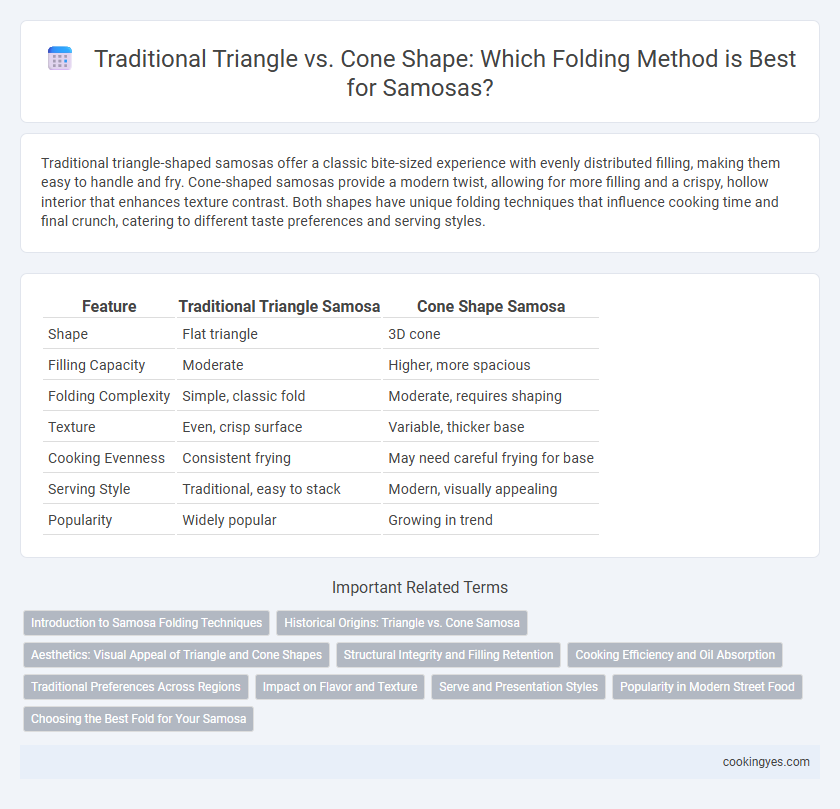Traditional triangle-shaped samosas offer a classic bite-sized experience with evenly distributed filling, making them easy to handle and fry. Cone-shaped samosas provide a modern twist, allowing for more filling and a crispy, hollow interior that enhances texture contrast. Both shapes have unique folding techniques that influence cooking time and final crunch, catering to different taste preferences and serving styles.
Table of Comparison
| Feature | Traditional Triangle Samosa | Cone Shape Samosa |
|---|---|---|
| Shape | Flat triangle | 3D cone |
| Filling Capacity | Moderate | Higher, more spacious |
| Folding Complexity | Simple, classic fold | Moderate, requires shaping |
| Texture | Even, crisp surface | Variable, thicker base |
| Cooking Evenness | Consistent frying | May need careful frying for base |
| Serving Style | Traditional, easy to stack | Modern, visually appealing |
| Popularity | Widely popular | Growing in trend |
Introduction to Samosa Folding Techniques
Traditional triangle folding for samosas preserves the classic geometric shape that ensures even cooking and a crispy texture, favored for its structural stability and ease of sealing. Cone-shaped samosas, an innovative variation, offer a modern twist that can accommodate more filling and create a unique eating experience, though they require precise folding skills to maintain integrity during frying. Both techniques highlight cultural heritage and culinary creativity, shaping preferences based on regional traditions and practical cooking needs.
Historical Origins: Triangle vs. Cone Samosa
The traditional triangle shape of samosas traces back to Middle Eastern and Central Asian culinary influences, symbolizing the three-pointed pyramid often linked with early Mughlai recipes. Cone-shaped samosas, more popular in regions like Maharashtra and South India, evolved as a regional adaptation that allows for easier folding and frying. Historical origins highlight the triangle as the authentic form rooted in Persian and Mughal kitchens, while the cone shape represents local innovation suited to contemporary cooking methods.
Aesthetics: Visual Appeal of Triangle and Cone Shapes
The traditional triangle shape of samosas offers a classic, geometric appeal that highlights sharp edges and symmetry, making it visually striking on serving plates. In contrast, the cone shape provides a sleek, modern aesthetic with smooth curves that enhance the samosa's elegance and can attract contemporary diners. Both shapes influence plating presentation, where triangles emphasize tradition and cones suggest innovation in culinary artistry.
Structural Integrity and Filling Retention
Traditional triangle-shaped samosas offer superior structural integrity due to their evenly folded layers, which distribute pressure more uniformly and reduce the risk of bursting during frying. Cone-shaped samosas, while visually appealing, often struggle with filling retention because the narrow tip can cause uneven sealing and leakage, especially with wetter fillings. Optimal folding techniques for samosas prioritize tight, consistent folds that maintain the snack's crisp texture and prevent filling spillage, ensuring a satisfying eating experience.
Cooking Efficiency and Oil Absorption
Traditional triangle-shaped samosas have a thicker dough layer that retains heat evenly during deep frying, resulting in a crisp exterior and fully cooked filling with moderate oil absorption. Cone-shaped samosas, featuring a tapered and thinner outer layer, cook faster due to increased surface area exposure and often absorb less oil, contributing to a lighter texture. The choice between shapes impacts cooking efficiency, with cone samosas offering quicker frying times and reduced oil uptake, while triangle samosas provide a sturdier structure ideal for retaining diverse fillings.
Traditional Preferences Across Regions
Traditional samosa folding commonly favors the triangle shape, especially in North Indian and Pakistani cuisines where the triangular form symbolizes cultural heritage and ease of handling. In contrast, the cone shape is more prevalent in certain South Indian and Middle Eastern regions, valued for its aesthetic appeal and convenient portion control. Regional preferences for samosa folding styles reflect diverse culinary histories and practical considerations unique to each locality.
Impact on Flavor and Texture
The traditional triangle shape for samosas promotes even frying, resulting in a crispier, uniformly cooked crust that enhances the overall texture. In contrast, the cone shape allows for a thicker filling-to-crust ratio, intensifying the flavor experience as the dense filling remains moist while the outer layer cooks to a golden crunch. Both folding styles impact the balance between crunchiness and filling juiciness, influencing the sensory enjoyment of this popular snack.
Serve and Presentation Styles
Traditional triangle-shaped samosas offer a compact, sturdy structure ideal for handheld serving, enhancing ease of eating during casual gatherings. Cone-shaped samosas provide a visually appealing, elegant presentation suited for formal events, allowing creative stuffing arrangements visible at the wider opening. Both shapes influence sauce dipping techniques, with triangles enabling uniform dips and cones facilitating layered fillings showcase.
Popularity in Modern Street Food
Traditional triangle samosas remain popular in many regions due to their classic appearance and ease of folding, appealing to consumers seeking authenticity. Cone-shaped samosas are gaining traction in modern street food scenes for their innovative look and convenient eating experience, often perceived as more portable and trendy. The rising demand for visually distinctive snacks has led vendors to experiment with cone shapes, balancing tradition with contemporary fast-food culture.
Choosing the Best Fold for Your Samosa
Choosing the best fold for your samosa depends on texture and presentation preferences; traditional triangle folds create crisp, layered edges that enhance crunch, while cone folds offer a compact, uniform shape ideal for evenly cooked filling. Triangle-shaped samosas often hold more stuffing and provide a satisfying bite with distinct, flaky layers, whereas cone shapes are easier to seal and less prone to oil seepage during frying. Consider the filling density and frying method to decide between the classic triangle fold for textural contrast and the practical cone fold for convenience and consistent cooking.
Traditional triangle vs Cone shape for Samosa folding Infographic

 cookingyes.com
cookingyes.com